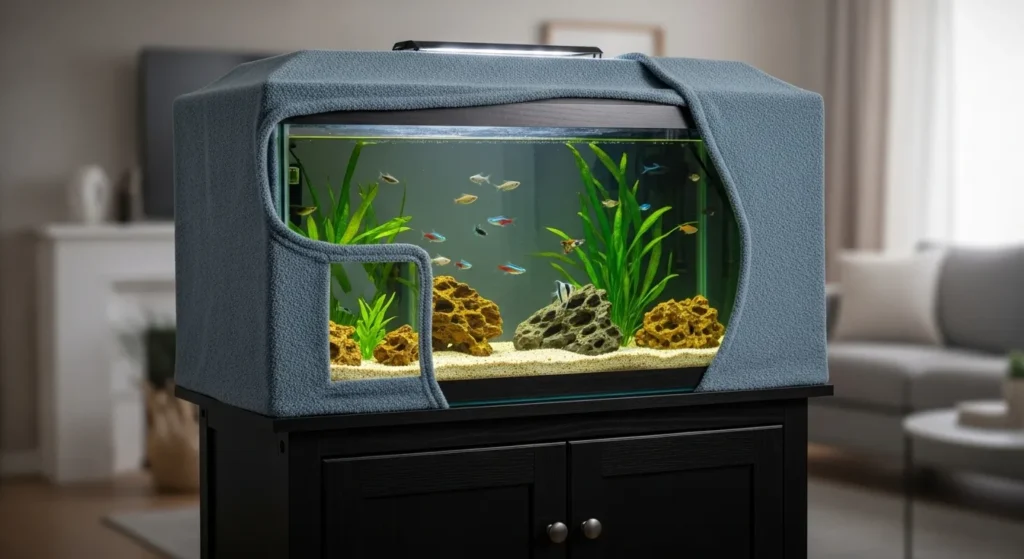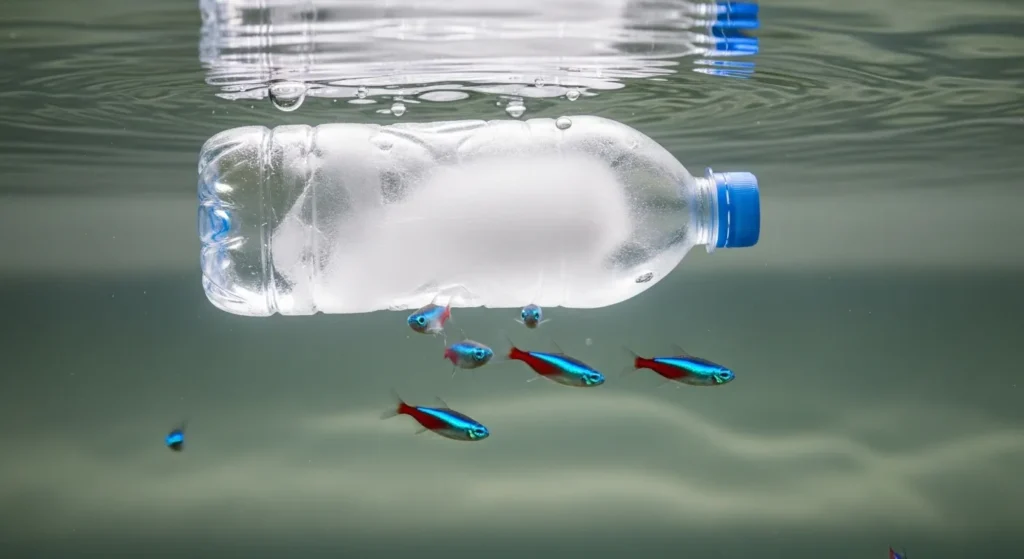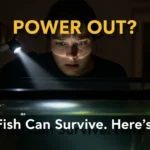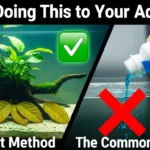It’s a feeling every fish keeper dreads. The lights flicker and die. The gentle hum of your filter cuts out, replaced by an unnerving silence. The power is out, and your beautiful, living ecosystem is suddenly on a countdown clock.
Your first feeling is a jolt of panic. Your mind starts racing: How long can the fish survive? Will the water get too cold? Will they run out of air?
Take a deep breath. You’ve come to the right place.
My name is Daniel, and I’ve been through my fair share of outages, including a winter ice storm that knocked out our power for over 18 hours. I remember staring at my dark, silent 40-gallon tank, feeling completely helpless. But that experience taught me that with a calm head and a clear plan, you can guide your aquarium through an outage safely.
This isn’t just a list of tips. This is a step-by-step survival guide. We’re going to walk through exactly what to do, what not to do, and how to prepare so you never have to feel that panic again.
The First 30 Minutes: Your Immediate Action Checklist
Time is critical, but don’t rush. The first things you do can make the biggest difference.
- Check the Cause: Is it just your house? Check your circuit breaker. Is it the whole neighborhood? Look outside. Knowing the scale can give you a rough idea of how long the outage might last.
- Insulate the Tank: Immediately cover the top of your aquarium with a lid or plastic wrap, leaving a small gap for air. Then, wrap the entire tank (sides and top) in thick blankets, towels, or even cardboard. This is the single best thing you can do to preserve the water temperature.
- Do NOT Feed Your Fish: This is a golden rule. Do not give them any food. Undigested food and waste will quickly produce ammonia, and without a running filter, that becomes toxic fast.
- Assess Your Supplies: Do you have a battery-powered air pump? Do you have blankets? Know what tools you have on hand.

The 3 Silent Threats in a Power Outage
When the power goes out, three invisible dangers start to build in your tank. Our entire plan is about defeating these three threats.
Threat #1: Lack of Oxygen
This is the most immediate danger, especially in a heavily stocked tank.
Why it’s a problem: Your fish don’t breathe the oxygen atoms in water (H₂O). They breathe dissolved oxygen gas (O₂). A running filter creates surface agitation—the splashing and rippling at the top of the water—which is where the majority of this vital gas exchange happens. When the filter stops, the gas exchange stops, and your fish slowly begin to suffocate.
How to Keep Fish Alive with No Power:
The goal is simple: you need to manually agitate the water’s surface.
- The Scoop Method: Take a clean pitcher or cup, scoop out some tank water, and pour it back in from a height of a few inches. Do this every 15-30 minutes. The splashing creates surface movement and introduces oxygen.
- The Battery-Powered Air Pump: This is the single best piece of equipment you can own for an outage. A simple, cheap battery-powered air pump with an air stone is a lifesaver. Turn it on, drop the air stone in, and it will create all the oxygen your fish need for hours or even days.
Key Takeaway: If you do nothing else, find a way to move the water’s surface. Oxygen is your first priority.
Threat #2: Extreme Temperatures
Your fish are cold-blooded, meaning they can’t regulate their own body temperature. They are completely dependent on the water around them.
Why it’s a problem: Most tropical fish live in a stable temperature range, usually 75-80°F (24-27°C). A rapid drop or rise in temperature causes immense stress and can quickly become fatal.
How to Keep Your Aquarium Warm with No Power (In Winter):
Your goal is to slow down heat loss as much as possible.
- Blanket Insulation: As mentioned in the checklist, wrapping your tank is the #1 most effective method. A well-insulated tank can maintain its temperature for many hours.
- Avoid Opening the Lid: Every time you lift the lid, precious heat escapes. Only open it when you need to manually aerate the water.
- No Candles: Never place candles on or near the tank to try and heat it. It’s ineffective and a massive fire hazard.
How to Keep Your Aquarium Cool with No Power (In a Heatwave):
- Frozen Water Bottles: Float a sealed, frozen bottle of water in the tank. Don’t just drop ice cubes in, as they melt quickly and can alter your water chemistry.
- Increase Evaporation: If you have a battery-powered fan, aim it across the surface of the water. Evaporation is nature’s air conditioner and will cool the water down.

Threat #3: Toxin Buildup
This is the slow, silent killer. Your filter isn’t just for moving water; it’s a biological powerhouse.
Why it’s a problem: Your filter media is home to billions of beneficial bacteria. These bacteria are the heart of the nitrogen cycle, converting toxic fish waste (ammonia) into less harmful substances. These bacteria need oxygenated water flowing over them to survive.
When the filter stops, these bacteria start to die off within a few hours. When the power eventually comes back on, the filter can pump this dead, toxic sludge back into your tank.
How Long Can Fish Go Without a Filter?
Fish can survive for a surprising amount of time without the mechanical part of the filter, as long as you are manually providing oxygen and the temperature is stable. The real danger is the loss of the biological filtration.
- Preserve Your Bacteria: If the outage lasts for more than 2-3 hours, take the media out of your filter (the sponges, ceramic rings, etc.) and place it in a sealed bag or container with some tank water. This keeps the bacteria alive. When the power returns, you can simply put the media back in the filter.
Key Takeaway: Your filter is a living thing. During a long outage, your job is to keep the beneficial bacteria inside it alive.
Power’s Back On: The Recovery Plan
The lights flicker on. The filter hums back to life. Don’t relax just yet. The next 30 minutes are crucial for a safe recovery.
- Check on Your Filter Media: If you didn’t remove your filter media during the outage, take it out now. Give it a gentle rinse in a bucket of old tank water (never use tap water!) to remove any dead bacteria before putting it back in the filter.
- Test Your Water: Do a quick test for ammonia. If the outage was long, there might be a small ammonia spike.
- Should I do a water change? Yes. It’s always a good idea to do a 25-30% water change after an outage. This helps remove any toxins that may have built up and re-oxygenates the water.
- Feed Lightly: Wait a few hours after the power returns, then give your fish a very small feeding. Their systems have been under stress.
Long-Term Preparation: The “Peace of Mind” Kit
The best way to handle a power outage is to be ready for it. Here’s what every aquarium owner should have in an emergency kit.
- A Battery-Powered Air Pump: This is not optional. It’s the most important piece of emergency equipment.
- A UPS (Uninterruptible Power Supply): This is essentially a big battery backup. Plug your filter into a small UPS like this one, and it can keep your filter running for several hours after the power goes out, bridging the gap for short outages.
- Thick Blankets: Have a dedicated “aquarium blanket” ready to go.
| Item | Priority | Purpose |
|---|---|---|
| Battery Air Pump | CRITICAL | Provides essential oxygen. |
| Blankets/Towels | CRITICAL | Insulates and maintains temperature. |
| UPS Battery Backup | HIGHLY RECOMMENDED | Keeps filter running during short outages. |
| Pitcher/Cup | ESSENTIAL | For manual aeration if you have no pump. |
Frequently Asked Questions
How long can my fish survive a power outage?
It depends on your tank size and stocking level, but with the steps above, fish can survive for 24 hours or even longer. The key is providing oxygen and maintaining temperature.
Do I need to feed my fish during a power outage?
No! This is very important. Do not feed them at all. Healthy fish can easily go a day or two without food. Feeding will only foul the water.
How do I give my fish oxygen without a pump?
Use a cup to scoop water out and pour it back in from a few inches up. This splashing action is surprisingly effective at oxygenating the water.
You’ve Got This
A power outage is stressful, but it doesn’t have to be a disaster for your aquarium. By staying calm, focusing on the three main threats—oxygen, temperature, and toxins—and having a simple plan, you can be the hero your fish need.
Now that you’re prepared for an emergency, why not take the next step in becoming a pro aquarist? Learn about the heart of your aquarium’s health by reading our Ultimate Guide to the Nitrogen Cycle.

Daniel Ravera is the founder of AquaInitium, where he shares insights gained from over a decade of hands-on aquascaping. His expertise lies in the low-tech, ecosystem-first method—a philosophy he adopted after experiencing the common frustrations of algae and instability himself. As an authority in the beginner aquascaping niche, Daniel provides clear, trustworthy advice to help you build a beautiful, stable aquarium and avoid the costly mistakes he learned the hard way.










